Saving Tomato Seeds
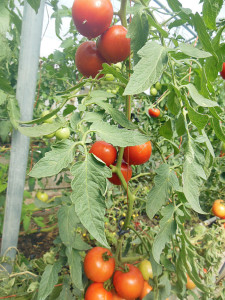 In times past, before the big seed companies, every family would save their own seeds or gather them from the wild. Saving seeds was a tradition passed down from one generation to another. It was not hard to do, just another task in the continuing cycle of the family life.
In times past, before the big seed companies, every family would save their own seeds or gather them from the wild. Saving seeds was a tradition passed down from one generation to another. It was not hard to do, just another task in the continuing cycle of the family life.
Today we are all spoiled. Our seeds come in pretty little packages with the seeds all cleaned and ready to plant. If our ancestors can save their own seeds, so can we. With a little knowledge and a few gadgets, we will be on our way.
What Type of Seeds
The first step in the journey is to have the correct type of seeds to start with. Hybrid seeds will usually create offspring that are like one parent or the other. Saving seeds from a hybrid will usually give you unpredictable results. In order to save our own seeds, the non-hybrid seed is the best. If you look on the tag of the tomato plant and it had F1 or F2 on the name it is a hybrid. The non-hybrids are making a comeback and most seed companies are bragging about the non-hybrid or heirloom seeds that they are carrying. All heirloom or non-hybrid seeds would be fine for saving. Seed Savers Exchange has over 3800 varieties of tomato seeds to pick from. Find them at http://www.seedsavers.org/. This is an organization that is dedicated to saving the unique seeds of our world.
Pollination
This is where we get to talk about the “birds and the bees”. All plants need to have a pollinator in order to form a seed. Some plants will self pollinate their own seeds and some plants will need a similar plant to cross pollinate. Tomatoes are self pollinated and pollinated by bees. Tomatoes can cross pollinate with other tomatoes. To save seeds, keep all different varieties of tomatoes separated as far apart as the garden will permit.
Parent Selection
Plants, just like animals, will carry the genetic blue prints of their parents. When selecting a plant to save seeds from, you will want to keep the best plant with the strongest traits. If you select a weak, spindly plant, the seeds produced will grow more weak and spindly offspring. The best way to select a plant for seed saving is to keep your best plant out of the whole group for seeds. You will need about 6 tomatoes
to get all the seeds that your want. You will want to mark these tomatoes with bright ribbon to keep the fruit from being harvested. It is mighty hard to leave a huge juicy ripe red tomato on the vine until it almost falls off from being over ripe!!
Year after year, as you select the best plant to save seeds off of, you will be developing a new strain of your own plant. It will start to take on characteristics of its own. It will adapt itself to your soil and growing conditions. These new characteristics will make your plant stronger in your garden than any seed you would buy.
Collecting the Seeds
Seeds need to be mature before they are removed from the parent plant. Vegetable seeds usually fall into three categories:
- seeds with flesh surrounding them,
- seed crops and
- seeds that scatter quickly upon maturity.
Seeds with fleshy covers need to stay on the plant until the vegetable is “over ripe” and ready to drop to the ground. Plants such as tomatoes, eggplant and peppers belong in this category.
How to save the seeds
Plant your tomatoes as if you were going to eat the tomato. Save the best six tomatoes for seed. Leave them on the vine until they are dead ripe.
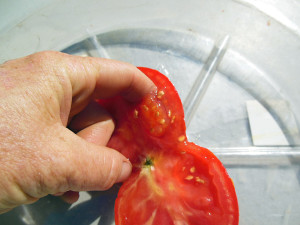
Pick the tomatoes then cut them open and scoop out the seeds.
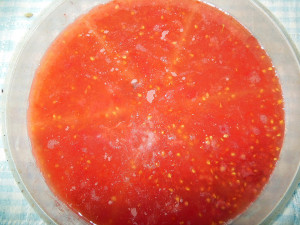
Place the seeds in a bowl of water and stir. Leave the bowl of seeds out on the counter for a few days. A white stinky scum will form on the top of the water. Do not leave over 3 days.
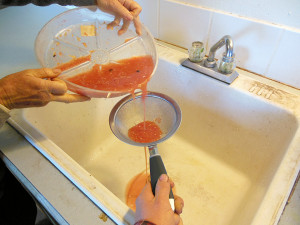
Once the scum forms on the water surface, dump the seeds through a screen strainer to wash out the pulp.
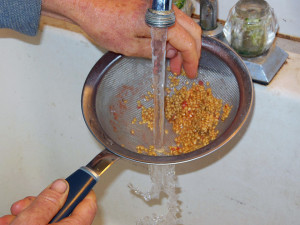
Run rinse water through the seeds until all of the pulp is gone.
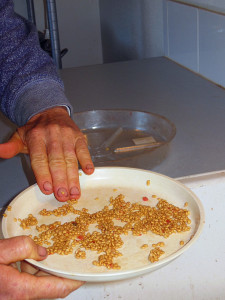
Place the seeds on a plate to dry. If you put the seeds on a paper towel, they will stick to it.
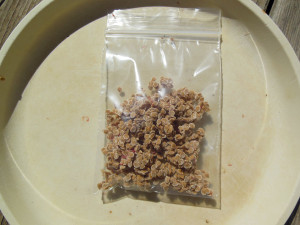
Once the seeds are dry, store them in a glass canning jar or an air tight bag. Be sure to label the seeds with the name, variety and the date.
Testing seeds
Before you plant your seeds it is best to test the seeds to see if they are going to sprout. This is a super easy job.
Take ten seeds and place between two sheets of paper towels. Keep the towels damp and in a warm place for three to ten days, checking the seeds every day. When you see roots and shoots coming out of the seeds they are good.
Count the number of seeds that germinated. If you have seven seeds out of ten than you have a 70% germination rate. As the seeds get older the germination rate will drop, this is normal. Let’s say you tested some carrot seeds and got a rate of 50%. Half of the seeds are still good.
If you have a low germination batch of seeds, sow the seeds a little bit thicker. It is wise to know how good the seeds will germinate so you can compensate for the germination rate when you plant your seeds.
As long as the seed will germinate it should be strong enough to grow a plant.
Seed Life Span
Different seeds have different life spans. There are reports of seeds that are hundreds of years old and they still germinate. How seeds are stored determines their longevity. Some seeds, no matter how they are stored, just don’t live long at all. If a seed is stored too hot (above 90° F) or too moist, it can be destroyed just days or weeks after harvest. I have had tomato seeds last 10 years when kept cold and dry.
Saving your own seeds can be a fun and rewarding hobby to add to your gardening. Plan on trying to save a few seeds next season.

